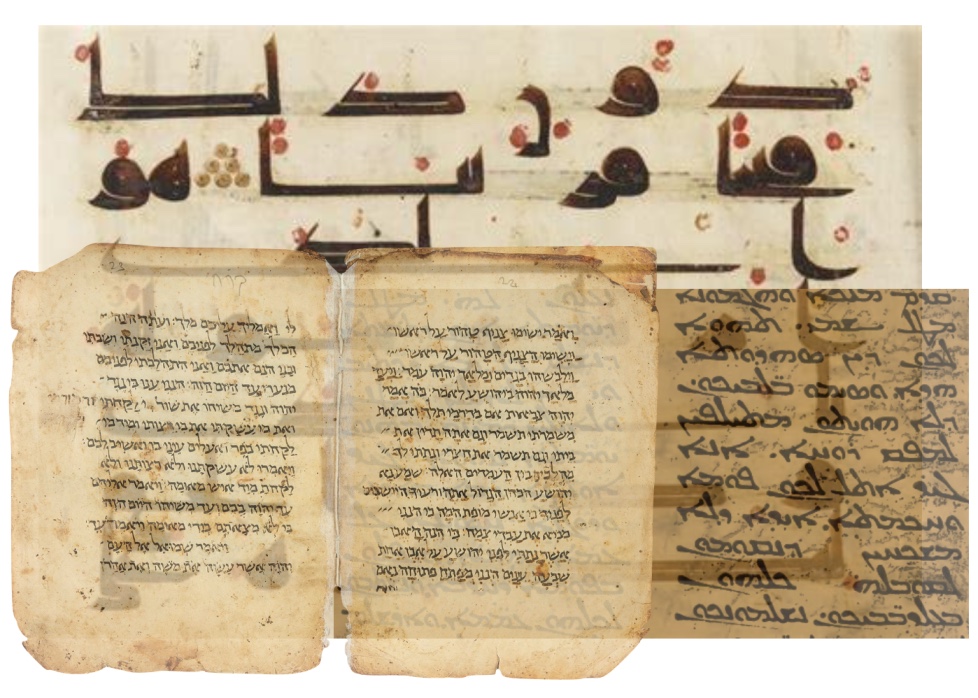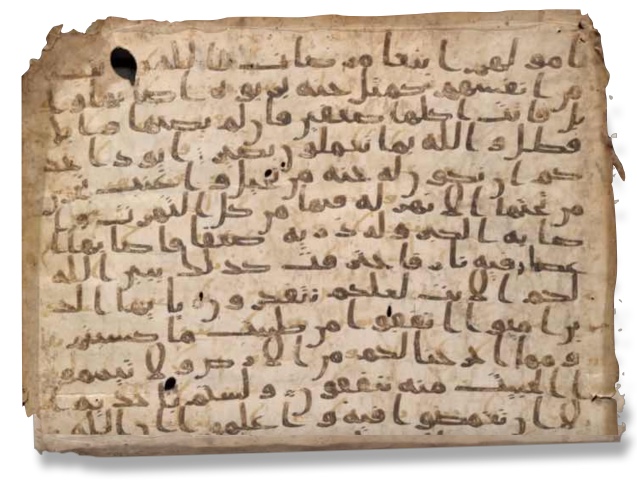
After the aforegoing review of the differences in readings, we now come to the story of the burning of the Qur’āns by ‘Uthmān ibn ‘Affān and the preservation of the Qur’ān compiled by the committee formed under the leadership of Zayd bin Thābit.
BY NAFI SHABOU
MĀLIK MUSULMĀNĪ MAKES the following comments on al-Kindī’s Risāla:
We understand from the Risāla of al-Kindī that the Qur’ān in the beginning was a gospel (the wrongly named Gospel of the Hebrews). The Jews (especially ‘Abd Allāh ibn Sallām and Ka‘b al-Aḥbār) inserted passages from of the Torah and other things into it, passages such as laws and tales of their own, and expanded or shortened the text in this way and inserted these distortions, such as their (now Qur’ānic) passage:
And the Jews say the Christians follow nothing (true), and the Christians say the Jews follow nothing (true); yet both are readers of the Scripture. Even thus speak those who know not. Allah will judge between them on the Day of Resurrection concerning that wherein they differ.[1]
The present text of the Qur’ān was not the work of a single person but was put together over a long period of time by several people, the last of whom was al-Ḥajjāj ibn Yūsuf Al-Thaqafī. Moreover, the Qur’ān was misinterpreted by the jurists and its interpreters since they were not familiar with the original ancient Syriac language of the Qur’ān, such as underpins the concepts of Ḥūr al-‘Ayn,[2] the marriage of two, three, or four[3], and the Hijab and so on.
Muḥammad Āl ‘Īsā in his work The History of Early Islam, writes:
The idea of multiple authors of the Qur’ān or compilers of the Qur’ān and even translators is confirmed by the large number of contradictions and objective differences in the text, in addition to the variations in style – these indicate the differences in the book. Each writer has his own style and spirit that can be sensed in the text. The idea of a compiling ‘committee’ doesn’t make sense. More logical is that they collected what they found in different sources and redacted it in Arabic.
Many reliable researchers hold that the first integrated Qur’ānic text drawn up for the reading as it is now was composed in the tenth century AD, while other manuscripts prior this date evidence different readings, such as the Ṣan‘ā’ version. Many researchers therefore are minded to understand the Qur’ān as a text that was authored, edited and revised by the Arabs of Syria and Iraq, and contains different readings which appeared over centuries before taking its final form that we know today.[4]
We can confirm what Muḥammad Āl ‘Īsā says from the letter of the Emperor of the Byzantines Leo III, to the Umayyad caliph ‘Umar ibn ‘Abd al-‘Azīz, which confirms that al-Ḥajjāj the provincial governor loyal to ‘Abd al-Malik ibn Marwān distorted and burned the ancient Qur’āns, as stated in the text of the letter:
We know that it was ‘Umar, Abū Turāb (‘Alī ibn Abī Ṭālib) and Salmān the Persian, who composed [your Furqān, i.e. the Qur’ān] even though the rumour has got round among you that God sent it down from the heavens … As for your (book), you have already given us examples of such falsifications, and one knows, among others, of a certain Ḥajjāj, named by you as Governor of Persia, who had men gather up your ancient books, which he replaced by others composed by himself, according to his taste, and which he propagated everywhere in your nation, because it was easier by far to undertake such a task among a people speaking a single language. From this destruction, nevertheless, there escaped a few of the works of Abū Turāb, for Ḥajjāj could not make them disappear completely.[5]
Much of the Qur’ān is missing
The manuscripts that have been discovered, especially the San‘ā’ manuscript which dates back to the middle of the first century AH, revealed on close examination erasures and over-writing, which confirms the existence of distortion, as evidenced in radiocarbon tests. The current Qur’ān has many errors in it, in the form of additions or omissions from the original Qur’ān.
Leo III’s letter to the Umayyad caliph ‘Umar ibn ‘Abd al-‘Azīz is confirmation that the current Qur’ān is not the Qur’ān existing during the era of Muḥammad, since it underwent alterations under the caliphs who came after Muḥammad.
The researcher Nādir Qurayṭ quoted the orientalist Karl-Heinz Ohlig on this:
There is clear repetition in the Qur’ānic text, at times synonymous or contradictory, indicating the influence of later pens. This is shown by ancient written versions of the Qur’ānic text, and the fact that evidences for the Prophet are very late [the late appearance, that is, of his name on inscriptions and coins]. It would be unreasonable to skip over these problems, in addition to the fact that the complementary story of the Islamic expansion was composed by Muslims from the ninth century AD (that is, 150-200 years following the Hijra), and there is a scarcity of documents from the first two Hijri centuries.
Ohlig concludes by outlining how Arab Christians composed books, explanatory works and commentaries on the Old and New Testaments in the Syro-Aramaic language reflecting their conceptions. These were translated into Arabic during the reign of Abd al-Malik (ob.705 AD) or his son al-Walīd (ob.715 AD) who made Arabic the official language of the state. The references made to the destruction of the (divergent) Qur’ānic texts and the retention of the ‘Uthmānī text, date back to the ninth century AD (that is, 200 years after the Hijra). This points to the destruction of the original Syrian texts which were prevalent up until the beginning of the eighth century AD.
He adds that the copies of the Qur’ān in the eighth century contained errors or script, and it was a further 100 years before they took on their canonical Islamic form. This process took place in Iraq and in a Judaeo-Christian scriptural environment.
The present text of the Qur’ān was not the work of a single person but was put together over a long period of time by several people
Ohlig concludes by referring to Christoph Luxenberg’s The Syro-Aramaic Reading of the Koran,[6] which attempted to demonstrate the Syriac-Aramaic grammatical underpinnings to the Arabic of the Qur’ān. It offered new readings to some verses in the Qur’ān by clearing up the confusion caused by errors of punctuation and referring back to its Aramaic linguistic roots.[7]
The current Islam and Qur’ān are the Islam and Qur’ān authored by the ‘Abbāsids in the third century AH, and do not concord with the earliest da‘wā, which was never a kerygma of a new religion and when the term ‘Islam’ was non-existent. There is no reference to the existence of any Qur’ān revealed to a person named ‘Muḥammad’. It was not the purpose of the person with the sobriquet ‘Muḥammad’ to establish a new religion, and the name ‘Islam’ for the faith only appeared in the era of ‘Abd al-Malik ibn Marwān and in particular during the ‘Abbāsid period.

Suggested Reading
Researchers have found that the Muslim caliphs compiled the current Qur’ānic maṣḥaf, and the process of its composition continued for a few hundred more years before the Qur’ān came to be considered to have been revealed to Muḥammad.
The Qur’ān is simply a reader of the earlier Judaeo-Christian scriptures. The Qur’ān was still uncompiled during the era of Muḥammad who was reading the earlier scriptures. As for the term dhikr (‘remembrance’) contained in the Qur’ānic texts, this in the Qur’ānic idiom refers to the books prior to the Qur’ān. And in every context in these scriptures it denotes ‘guidance’, ‘preaching’ and the ‘teaching’ of the earlier scriptures, for you are but a reminder.[8]
This confirms to us that Muḥammad was not a prophet and received no revelation. He was simply reading earlier Syriac and Jewish works – the Torah, the Gospels, especially the Gospel according to the Hebrews.
[1] Qur’ān II (al-Baqara), 113.
[2] The Ḥūr al-‘Ayn (‘wide-eyed beauties’, or more specifically, beautiful women with pronounced whites of their eyes, and pronounced black pupils) are the women promised to the believers in paradise, as stated in Qur’ān XLIV (al-Dukhān), 54: And We shall wed them unto fair ones with wide, lovely eyes. On this, see the Almuslih article: The Hur al-‘Ayn fantasies. (Ed.)
[3] Qur’ān IV (al-Nisā’), 3: And if you fear that you cannot act equitably towards orphans, then marry such women as seem good to you, two and three and four; but if you fear that you will not do justice (between them), then (marry) only one or what your right hands possess; this is more proper, that you may not deviate from the right course.
[4] See M. A. ‘Īsā, تاريخ الاسلام المبكر in the Almuslih Library.
[5] For Arthur Jeffery’s analysis of this correspondence, see https://archive.org/details/Jeffrey1944HTRGhevond/page/n1/mode/2up The above quotation is on pp.292 and 297-8. The book is available for download in the Almuslih Library here (Ed.).
[6] On this work, see Almuslih article: An Aramaic and Syriac reading of the Qur’ān, Parts 1 and 2.
[7] See Nādir Qurayṭ’s article The Hidden Origins of early Islam (also published in Almuslih).
[8] Qur’ān LXXXVIII (al-Ghāshiya), 21.
On this essay read the earlier sections: Part One; Part Two; Part Three; Part Four; Part Five, Part Six; Part Seven; Part Eight

